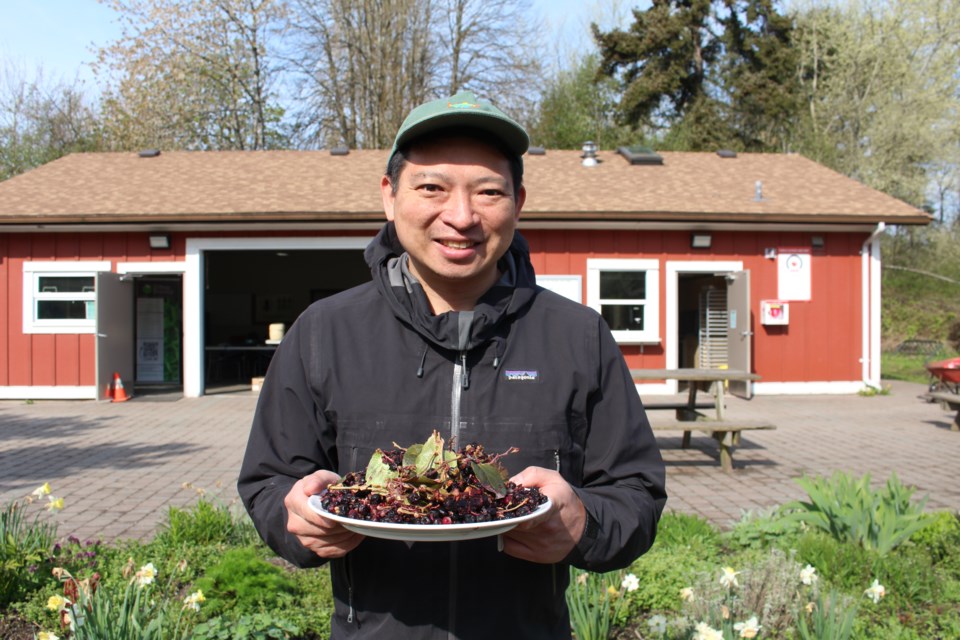Elderberry leaves, dandelions, blackberries, and even blackberry stems are some of the common plants around us that can be made into natural ink.
As a part of the city’s ‘Earth Week’ celebrations, artist Edward Fu-Chen Juan held an inkmaking workshop in The Red Barn at Terra Nova Rural Park this weekend. Participants learned to identify and forage common plants and fruits, and they got to experiment with inkmaking by boiling foraged materials and adjusting the colour using products like citric acid.
“It’s really inspiring. It’s neat to meet people from all over the Lower Mainland that have come to this particular Earth Day workshop and people with similar interests and values around materials,” said Janice Novakowski, a participant at the workshop.
Novakowski, a district teacher consultant at the Richmond School District, has been participating in Juan’s workshops because she’s interested in ways to connect to the land and in exploring different artistic techniques and materials.
She’s also hoping to apply what she learned at work, and provide science, math, and art experiences for students and teachers in the school district that “also connect to the land, the species of the land, and connecting to place in different ways.”
Inkmaking depends on the seasons
Participants dipped their toes into foraging by picking dandelions and elderberry leaves, but most of the materials used in the workshop were foraged by Juan last year, which he preserved by drying and freezing them.
“Spring just started, and a lot of things haven’t bloomed yet, or they just started coming out,” said Juan.
Juan wanted participants to think in the long term and consider how they can make their supply of art materials sustainable with the environment.
“And also I’m hoping that participants can understand you create the art with this change of the season. If you’re not able to store it, maybe you don’t get to create this colour this month because it’s just not in season, just like food… you can’t just go to the store and buy it. You have to go with the ones that nature is able to give you,” said Juan.
Not only is making ink with plant materials a seasonal affair, but it can also be unpredictable. Ink made from fresh materials will have different colours compared to those made with dried or frozen plants, and the same plants collected at different times can also produce different colours.
“Season to season it can change because the soil has changed or the climate has changed. I’ve seen where certain plants I’ve collected one year from another year the colour isn’t as strong, or it’s not saturated, or [the colour] even changes a little more acidic,” said Juan.
Find a community through foraging
For those who want to take a stab at foraging, Juan suggested that while you can grow your own plants, your local community be a better place to start.
“Anyone can forage from public land or crown lands. Or just getting to know your community garden, and the neighbours who have a lot of plants that they don’t want, [like] their weeds...” said Juan.
“Dandelion is a great material for making yellow ink, blackberries are great for making blue ink and black ink, even Elise and the stem of the blackberry — they’re really quite invasive, but you can use that to make a really beautiful mustard yellow,” he said.
Art cultivation from nature
The workshop is a part of Juan’s “Art Cultivation from Nature” project for his artist residency with the City of Richmond and Urban Bounty, where he aims to raise awareness by creating art with sustainable materials. The artist residency is part of the city’s Engaging Artists in Community Program.
Juan plans to expand upon the concept of growing your own art supply, and create prints using paper and ink that he will make with tree fibres and plants that are indigenous to B.C.
Juan will be holding two more workshops in June and July, where he will teach participants how to make paper using cedar bark peeling and cotton. Participants will also be able to write and do calligraphy using the paper that they made. The June event will be open to the general public, while the July event will focus on the BIPOC community and their experiences, which is an issue close to Juan’s heart.
He will also be creating a legacy project related to printmaking as a part of his residency, and he plans to reveal it at this year’s B.C. Culture Day.
For more information about Juan’s upcoming workshops and his artist residency, check out his artist blog.


2.JPG;w=120;h=80;mode=crop)
